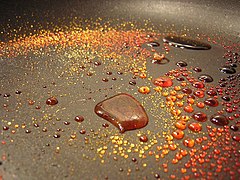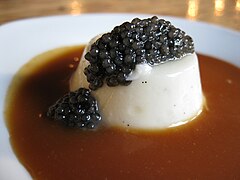Cookbook:Caramel
Cookbook | Recipes | Ingredients | Equipment | Techniques | Cookbook Disambiguation Pages

Caramel refers to sugar that is heated until it caramelizes. It is widely used in candies, baked goods, desserts, dips, sauces and other prepared food products. Often the term "caramel" is extended and applied to products made with the caramelized sugar, such as caramel sauces and confections.
Characteristics[edit | edit source]

As sugar increases in temperature, it begins to break down at the molecular level. This degradation, called caramelization, causes the formation of new compounds that provide deep, rich flavors and brown color. White table sugar will caramelize between 310–349°F (154–175°C), with more complex flavor and color the hotter it gets. However, around 350°F (176°C) the sugar smokes and eventually burns and turns black. Caramelized sugar by itself cools to a solid, glass-like consistency; for a softer consistency, liquid and/or fat are added to the plain caramel.
Techniques[edit | edit source]
There are two basic ways to make caramel: the dry method and the wet method. The dry method, which involves slowly heating sugar alone, is more difficult. The sugar begins browning from the edges in, and it must be repeatedly folded into the center until all the sugar changes color and before it begins to smoke excessively. Only after this are the other ingredients rapidly added.
In the wet method, sugar is dissolved in water, then boiled to allow the water to evaporate. As the water evaporates, the solution passes through the stages of cooking sugar, and the temperature increases. This allows the sugar to caramelize more gradually and evenly. Technically the temperature can be monitored, but the caramelization tends to progress very quickly, and many find it more convenient to assess the degree of caramelization by the color change; the darker the color, the stronger the caramel.
If you're producing caramelized sugar for later use, e.g. making your own invert sugar with a pinch of citric acid (sour salt), you can safely store the hardened caramelized sugar in a glass jar. Simply put the jar in a cold oven, bring to 300°F (149°C), and pour. Follow the same procedure when reheating to liquid form to avoid thermal shock.
Use[edit | edit source]
Caramel is used in a wide range of preparations to add flavor and color. Plain caramelized sugar can be poured or spun into shapes and used as a garnish. It can be tempered with liquid and fat to make caramel sauces or candies. It may also be incorporated into a custard or other simple preparation to add a more complex flavor.
Gallery[edit | edit source]
-
Sugar caramelizing on a hot pan
-
Baked custard with caramel
-
Caramel-coated apple
-
Caramel confection
-
Popcorn coated with caramel
-
Caramel ice cream
-
Panna cotta in caramel sauce






